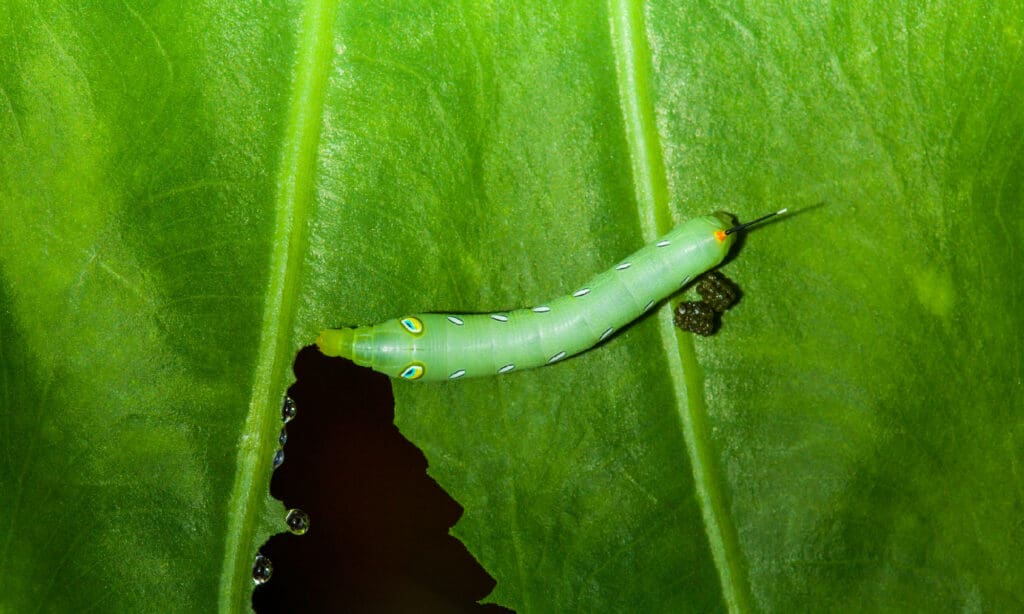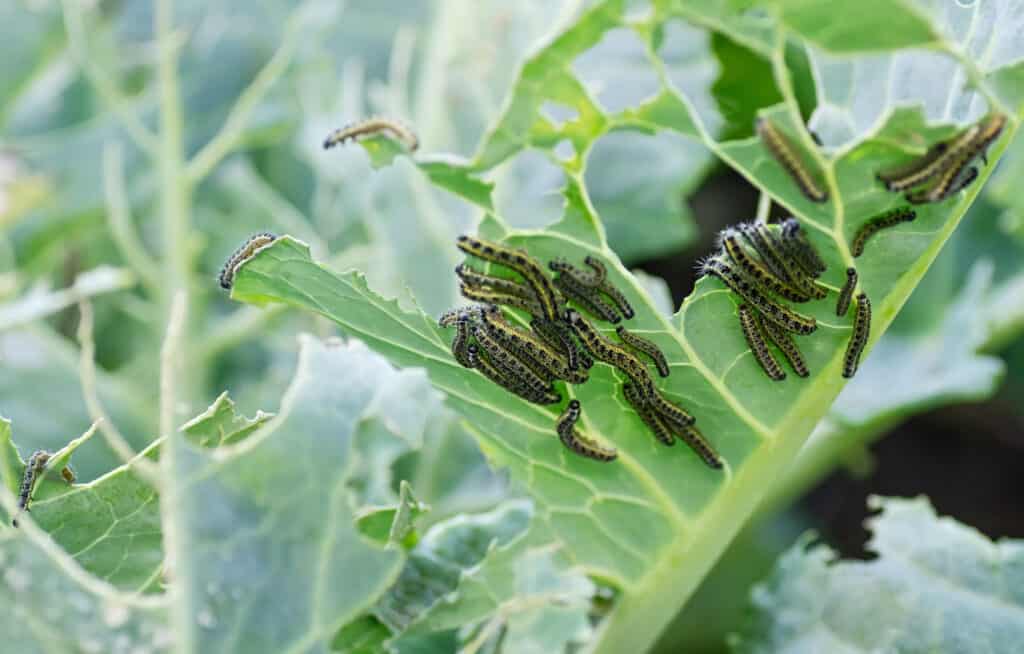There are at least 180,000 species of caterpillars worldwide, and scientists are still discovering more in remote areas. As such, they’re classified into various groups for easy identification.
These categories include Hesperiidae, Papilionoideae, Pieridae, Riodinidae, Lycaenidae, and Nymphalidae. Besides their classifications, one can also identify caterpillars by their sizes, color, hair covering, markings, and horns. For instance, the caterpillars in the Lycaenidae family have blue and black coloration, while those in the Riodinidae family typically have metallic marks.
Did you know that the only thing a caterpillar does is eat and grow bigger before turning into a moth or butterfly? There are numerous facts to learn about caterpillars. However, in this article, we’ll focus on the interesting facts surrounding their poop. Let’s get started.
What Does Caterpillar Poop Look Like?

Caterpillars defecate in the form of pellets.
©iStock.com/SuwanPhoto
Like many other insect feces, we describe caterpillar poop as “frass.” Caterpillars defecate in the form of pellets which one may notice on the ground around them. Sometimes, however, the caterpillar may release them afar off as a protective mechanism against predators. Predators like wasps typically trail the smell of a caterpillar’s poop to find them.
However, some caterpillars poop in their homes. These caterpillars tend to expand their tents to move away from their built-up poop instead of shooting them as far away as possible. Examples of such caterpillars are tent caterpillars and leaf miners.
Since caterpillars eat a lot, it’s no surprise they also defecate a lot. A caterpillar’s frass contains undigested food materials as well as bacteria and fungi.
What is the Green Stuff Coming Out of a Caterpillar?
It’s definitely not poop! In fact, in defense against attacks, caterpillars expel a green fluid containing partially digested vegetation. This fluid already contains substances with unappealing odors and flavors to deter predators, notably birds.
Caterpillars have the ability to regurgitate partially digested plant matter, and exposure to insecticides or pesticides can often induce them to emit bright green vomit.
Further, hemolymph (or caterpillar blood) consists primarily of water, but it also holds ions, carbohydrates, lipids, glycerol, amino acids, hormones, some cells, and some color pigments. Resulting in blood appearing yellow or greenish.
What Do Caterpillars Eat?

Caterpillars primarily feed on plant parts.
©Elena_Gr/Shutterstock.com
As herbivores, caterpillars primarily feed on plant parts, especially leaves. Their leaf diet satisfies their water needs as they don’t drink water. Besides leaves, some caterpillar species love to feast on flowers. They enjoy buds, petals, pollen, and seeds. One may also find some caterpillars eating feathers, hair, and fur. Many times, these are the caterpillars that live in human homes.
Some caterpillar species, especially wax moth caterpillars, invade and destroy hives to create room for laying their eggs. During this period, they make do with what they find in their environment. This means that they can eat honeycomb. Other food sources for caterpillars include grass, bark, twigs, and red ants.
Some caterpillars, especially the skin moth caterpillars, eat animal waste. They love to munch on dead animal skins, including guano, birds, mice, and owl pellets.
Although caterpillars are generally vegan, some species eat insects and may even make a meal from other caterpillars.
Do Leaf-eating Caterpillars Trick Plants With Their Poop?

Caterpillars like armyworms trick plants with their poop.
©The natures/Shutterstock.com
Caterpillars that feed on corn leaves have developed smart methods of getting the most nutrients from their meals. According to some scientists at Pennsylvania State University, they do this by tricking the plants with their poop.
The chemical signals from their poop deceive plants into believing they are suffering from a fungal infection instead of an insect attack. Note that corn plants have two defense lines—one attacks insect pests and the other targets fungal infections. Unfortunately, they can’t use the two of them at a time. Since corn plants can’t effectively handle several attacks at once, they’ll focus all their attention on fighting this perceived fungal infection.
This allows the caterpillars to feast on the leaves without interference. A perfect example of caterpillars that have successfully mastered this technique is the armyworm.
Without this smart strategy, caterpillars will have difficulty getting enough nutrients from the corn plants. That’s because the plant will quickly recognize the insect “attack” through their secretions and try to defend itself by releasing a biochemical that repels them.
Is Caterpillar Poop Dangerous?
There’s hardly enough evidence to determine if caterpillar poop is dangerous to humans. However, humans must be careful when approaching areas that they’ve fed on, as they can come in contact with human pathogens in the process.
What’s Caterpillar Poop Good For?

Caterpillar droppings can serve as good nutrient sources for plants.
©iStock.com/dzphotovideo
When it comes to manure, caterpillar poop is likely not to be a farmer’s first choice. The reason for this is obvious—caterpillar feces is too small. However, caterpillar droppings can serve as good nutrient sources for plants. There are also reports that caterpillar poop may be useful as pesticides.
The photo featured at the top of this post is © iStock.com/Weber
Thank you for reading! Have some feedback for us? Contact the AZ Animals editorial team.






